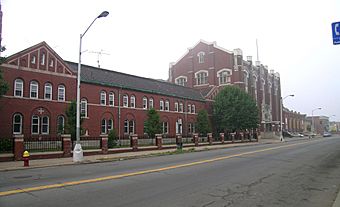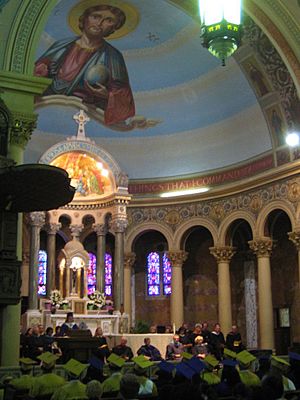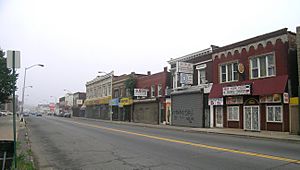West Vernor–Junction Historic District facts for kids
Quick facts for kids |
|
|
West Vernor–Junction Historic District
|
|

South side of Vernor at Junction, looking southwest, along the boundary of Holy Redeemer parish.
|
|
| Location | Detroit, Michigan, U.S. |
|---|---|
| Architect | Donaldson and Meier; Jogerst, Joseph P.; et al. |
| Architectural style | Late Victorian, Romanesque, Art Deco, Early Commercial |
| MPS | West Vernor Highway Survey Area, Detroit, Michigan MPS |
| NRHP reference No. | 02001503 |
| Added to NRHP | December 12, 2002 |
West Vernor–Junction Historic District is a special area in Detroit, Michigan. It's a historic district, which means it's a place with important old buildings and history. This district is found along West Vernor Highway. It covers about 160 acres and has 44 buildings. The district was added to the National Register of Historic Places in 2002. This listing helps protect its history.
Contents
History of the District
From Farms to Shops
In the 1860s and 1870s, the area of the West Vernor–Junction Historic District was mostly quiet farmland. But things started to change in the 1880s. The large farms began to be divided into smaller plots for homes.
By 1881, a wooden Catholic church was built at what is now Vernor and Junction. This church later became the Most Holy Redeemer Church.
Growth and New Buildings
During the 1880s and 1890s, many wooden shops were built along Vernor Highway. Some of these old wooden buildings are still standing today. A few brick commercial buildings also appeared.
More brick buildings were constructed in the 1910s and 1920s. This was a time of big growth for the neighborhood. It happened because the nearby Ford River Rouge Complex was built. This brought many new jobs and people to the area.
Lithuanian Community
Many people from Lithuania moved to Detroit during World War II. A lot of them settled in the Southwest side of the city, especially in the West Vernor area. The Lithuanian Hall in the area was renovated and reopened in 2006.
St. Anthony's parish, a church at 1750 25th Street, became a main gathering place for Lithuanian immigrants. It even held services in the Lithuanian language until it closed in 2013.
What the District Looks Like
The West Vernor–Junction Historic District is next to Mexicantown. It is home to a large and lively Latino community. This area is one of the few places in Detroit that still has many old wooden commercial buildings. It's also one of the few neighborhood shopping areas that has survived through Detroit's economic challenges.
Buildings and Architecture
Most buildings in the district are two stories tall. They are made of wood or brick. The buildings located east of Junction Avenue are generally older. Some of them date back to the 1890s. The blocks west of Junction were mostly built in the early 1900s.
Famous Buildings
One important building is the Stratford Theatre at 4751 W. Vernor Hwy. It was designed by Joseph P. Jogerst. When it opened in 1916, it could seat 1,137 people. The theater has a cool Art Deco style. Since 1985, the Stratford has been used as a retail store.
Another great example of Art Deco style is the nearby Brown's Bun Bakery. It has a unique white enameled metal panel on its front.
Most Holy Redeemer Church
The district also includes the historic Most Holy Redeemer Church. It was designed by architects Donaldson and Meier. This church was once thought to be the largest Catholic parish in North America. It is also one of the biggest church complexes in Michigan.
The church complex includes the main Neo-Romanesque church and monastery from 1923. There's also a Late Gothic Revival auditorium. The school and gymnasium, built in 1928, are now Detroit Cristo Rey high school. A convent building was added in 1939. Most of these buildings were designed by the Donaldson and Meier firm. The church still serves the local community today.
In Culture
The neighborhood was featured in a Hollywood movie called The Rosary Murders. This film came out in 1987 and starred actor Donald Sutherland.
See also
 In Spanish: Distrito Histórico de West Vernor-Junction para niños
In Spanish: Distrito Histórico de West Vernor-Junction para niños



